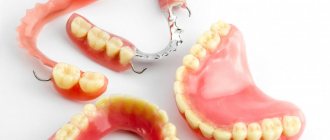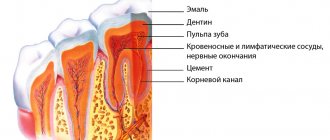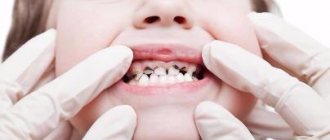When deep caries reaches the dental nerve, pulpitis begins - during pregnancy it is much more severe than in ordinary patients. And if the expectant mother postpones a visit to the doctor and suffers pain, this can affect the baby’s health.
Untreated pulp inflammation becomes chronic with periodic exacerbations, and there is a high risk of serious purulent complications. Sluggish pulpitis in pregnant women contributes to the penetration of infection into the blood, which means that the developing fetus may also suffer. Therefore, at the first signs of illness, you should see a dentist, for example, come to the VAODENT clinic.
Characteristics of the pathology
This disease is an inflammatory process in the dental pulp. Inflammation can develop if caries treatment is not carried out in a timely manner. The disease begins to progress and eventually affects internal tissues.
In pregnant women, the situation is complicated by hormonal imbalances and a constant lack of minerals and trace elements in the body. The main role here is played by a lack of calcium, due to which the skeletal system is formed and maintained. In this case, not only the pain syndrome, which significantly complicates the life of the expectant mother, is important, but also the detrimental effect of the inflammatory process on the child in the womb.
It is possible and even necessary to treat the pulp in this condition. If the situation is left to chance, a progressive infection can cause significant harm, and only timely intervention by a dentist will help avoid serious problems and numerous complications.
Remember, a pregnant woman should take any medications (analgesics) only after consulting a doctor.
Causes
Inflammation provoked by infectious agents progresses in the form of focal lesions. Often it affects not only the enamel layer of the tooth, but also its neurovascular system.
The disease can occur in acute or chronic form. It develops as a consequence of deep advanced caries. Therefore, a woman should consult a specialist already at the time of planning motherhood. After all, in a short period of pregnancy, even in the 1st trimester of pregnancy, pulpitis is already a serious problem, which is much more difficult for an expectant mother to solve than for an ordinary patient. Treatment of a diseased pulp will be significantly more complicated due to its condition.
How quickly the pathology will progress depends on a number of factors, including: the individual characteristics of the body, how long ago the first symptoms appeared.
The rate of development of the disease can also be affected by:
- decreased immunity;
- lack of calcium, magnesium, phosphorus.
Symptoms
The inflammatory process develops quickly, leading to a rapid deterioration in well-being. Its pronounced manifestations are:
- severe pain, most often manifested at night;
- high tooth sensitivity when eating cold or hot food;
- increased body temperature, which in some cases can reach 38°C.
Experiencing unremitting pain, the expectant mother is in a constant state of stress. At the same time, the body releases hormonal substances, which is very unsafe for the baby in the womb.
Symptoms of tooth pulpitis
How can you determine that your tooth hurts precisely because of the development of pulpitis? This disease has its own characteristic symptoms and the first sign of the development of pulpitis may be pain that occurs when a diseased tooth comes into contact with cold/hot, sweet/sour foods. Unlike pain during caries, these sensations do not go away immediately after the irritant that caused them is eliminated: they persist for longer than 15 minutes. If you are bothered by such sensations during and after eating, you need to urgently contact your dentist for diagnosis and treatment of pulpitis.
It is important to understand that without proper treatment, pulpitis will not go away: the inflammatory process will continue to develop and this will lead to the transition of pulpitis to an acute form. In acute pulpitis, pain can occur suddenly and on its own, without external influence. Pus collects in the pulp, and if there is no natural outlet for its outflow, it begins to put pressure on the bundle of nerves, and severe pain occurs.
At first, this pain can be eliminated by taking tablets from the pharmacy, but if treatment for pulpitis is not carried out, pharmacy painkillers will no longer help. The pain will be excruciating and constant, moreover, it can spread along the nerve endings to different parts of the oral cavity. For this reason, people who go to the doctor for treatment of acute pulpitis often cannot pinpoint exactly which tooth is hurting. In acute pulpitis, swelling of the gums and increased body temperature may be observed.
Pulpitis is not only acute - it has its own fairly extensive classification into various forms, and each form of pulpitis has its own symptoms. Accurate determination of the form of pulpitis is of fundamental importance for choosing an effective method of treating it. Below we will look at all seven main forms of pulpitis and their main symptoms.
Fibrous pulpitis of the tooth
The development of a fibrous form of pulpitis may be indicated by mild, aching pain, which occurs most often when a tooth comes into contact with hot/cold food during chewing. The pain is usually localized quite clearly - in one tooth. If fibrous pulpitis is not treated in time, then as the disease develops, pain may appear on its own and not stop for 24-48 hours.
Hypertrophic form of pulpitis
With this form of pulpitis, patients who go to the doctor for treatment complain of a viscous, aching pain, which often occurs when eating. This pain causes people to avoid chewing on the side of the jaw where the painful tooth is located. Another sign of hypertrophic pulpitis may be bleeding gums that appear when brushing teeth in the area of inflammation.
Gangrenous pulpitis and its symptoms
This form of pulpitis is also characterized by aching pain that occurs under the influence of chewing load on the teeth or from contact of the diseased tooth with temperature irritants. A person with the development of gangrenous pulpitis may experience the appearance of extremely unpleasant odor from the mouth, which cannot be removed by the standard procedure of brushing teeth and rinsing with balms. When, when treating gangrenous pulpitis, the dentist opens the tooth cavity, thick gray pus with a fetid odor is found in the area of inflammation.
Chronic pulpitis and signs indicating its development
This form of pulpitis is insidious in that it may not show itself for a long time.
Chronic pulpitis can be detected only after diagnostic measures are carried out or when it transforms into an acute form, which has bright and pronounced symptoms. Acute pulpitis, which has not been treated, can become chronic. But you shouldn’t think that you can continue to calmly live with a bad tooth and not take any measures to treat it. Chronic pulpitis sooner or later turns into acute and then a person is simply forced to see a doctor, because the pain becomes unbearable and pills from the pharmacy cannot save it.
To choose an effective treatment method, you need to conduct a high-quality diagnosis that allows you to determine the form of pulpitis and the stage of development of inflammation.
Is it possible to treat pulpitis during pregnancy?
Despite the woman’s delicate position, therapy is necessary. And this needs to be done quickly. A rapidly progressing infection will cause much more harm than the medications used in treatment.
Most pregnant women are mistaken in believing that eliminating pathology is contraindicated for them. Moreover, dentists themselves some time ago did not recommend therapy for expectant mothers. The main fears that arise when medical intervention is necessary are the following prejudices:
- the likelihood of miscarriage or premature birth;
- fear of using anesthesia that is dangerous for the baby in the womb;
- the involvement of arsenic in eliminating the nerve;
- negative effects of x-rays (take a picture if necessary);
- anxiety when using a reflective lamp during therapy (known to many as “blue”).
All these worries are completely unfounded. When treating an inflamed pulp in an expectant mother, Dentik must take into account the biological features of its position.
Therefore, even in the 2nd and 3rd trimester of pregnancy, pulpitis can be cured. It is important to first consult with a gynecologist who is observing the woman. And when visiting the dental office, the first thing you should do is tell the doctor about your condition.
What are the difficulties of therapeutic intervention?
During this period, all medical procedures are carried out on a smaller scale. During the process, the pregnant woman should not experience pain. The best time to solve dental problems is 3-6 months of gestation. At this point, the placental protection has already been formed; accordingly, the baby is completely protected from the negative influence of foreign substances (medicines).
If the pathology manifests itself in a given time period, there is no need to refuse therapy. It is necessary to contact a specialist and eliminate the problem in order to avoid possible complications due to the development of infection.
When figuring out how to treat pulpitis on teeth during pregnancy, it is worth knowing that doctors do this as carefully as possible. They try not to cause pain to the patient and use only safe drugs. Treatment and filling of dental canals is carried out using completely harmless materials.
It is better to carry out all medical procedures in relation to the expectant mother without anesthesia. If this is not possible, for example, when removing a nerve, dentists use non-adrenaline compounds for pain relief.
Exposing a woman to x-rays is also extremely undesirable. However, if necessary, photographs are still taken, using modern equipment and observing all the necessary safety measures.
When contacting a specialist, a pregnant woman is obliged to notify him of the exact date of her condition, describe her state of health and tell him about the presence of allergic reactions to medications.
Medical devices and medications of the latest generation minimize the negative impact on the body of mother and baby. Therefore, treating dental diseases is not only possible, but also necessary. Of course, ideally, it is better to prevent the occurrence of a disease by solving emerging problems in a timely manner.
First aid for acute toothache. How to relieve pain at home?
- For completely unbearable toothache, you can take painkillers. The safest medications during pregnancy are those containing paracetamol.
- Clean the carious cavity, rinse your mouth with a warm solution, which contains: 1/2 teaspoon of baking soda, 1/2 teaspoon of salt and a few drops of iodine.
- You can use dental drops (Denta or others) by applying a swab soaked in them to the gum.
- Attacks of pain are reduced by rinsing the mouth with herbs: a decoction of calendula, chamomile, valerian, St. John's wort, plantain.
- A very ancient and effective remedy is applying garlic to a sore tooth. You can also apply crushed garlic to the pulsating vein on the wrist (to the left hand for tooth pain on the right side and to the right hand if the tooth hurts on the left side).
- Never apply warm compresses to a sore spot.
Important! The listed methods are temporary - they will only slightly reduce toothache, but will not cure pulpitis! So don't put off visiting the dentist!
What are the dangers of untreated pulpitis?
As has been said many times above, therapy is necessary. This is due to the following factors:
- During the period of gestation, a woman’s immune system becomes unstable, immunity weakens, which contributes to the rapid development of pathology.
- To prevent the spread of infection and stop the inflammatory process, the acute phase of the disease must be eliminated. An inflamed pulp is a source of infectious agents that affect the entire body. In advanced cases, even blood poisoning cannot be ruled out.
- If harmful microorganisms enter the gastrointestinal tract, preeclampsia may occur - severe toxicosis in the later stages of pregnancy.
- In some cases, eliminating complications is impossible without the use of antibiotics, which is very undesirable for the expectant mother.
- If you consult a dentist in a timely manner, the nerve will not be removed. Therefore, the use of medications (anesthesia) is excluded.
- When treatment for pulpitis on teeth in pregnant women is not carried out, the infection begins to spread and affects the periodontium, which invariably leads to an inflammatory process at the root (periodontitis). When neglected, there is a high probability of removal.
- An untreated disease leads to suppuration inside the gums. This is how periostitis (flux) appears.
An incorrectly selected therapeutic technique can also provoke serious complications. But at Dentik you can be sure that dentists are prescribed the procedures indicated for them or medications that are safe for the health of the mother and the condition of the child.
Effect on the fetus
It is not for nothing that doctors recommend therapy for pulp disease even during pregnancy. Exposure to X-rays and drugs, while undesirable, is not as harmful as the risk of infection to an unborn baby. Lack of timely treatment can lead to a number of dangerous consequences:
- Inflammation acts as a source of infectious agents. Toxic substances and harmful microorganisms penetrate a woman’s blood, creating a risk of infection of the gestating fetus.
- The psychological state of the expectant mother is no less important, since the baby directly depends on her emotional mood, and intense pain can lead to the release of hormones.
- The use of anesthetics is not recommended in the first trimester, as the drugs may contribute to developmental abnormalities in the child.
- The bodies of mother and baby are closely interconnected. A diseased tooth, which spreads infection, poses a serious threat to both.
Impact on maternal health
For the woman herself, refusal to undergo therapy is no less dangerous. Putting off fixing the problem until later is the wrong decision.
An inflamed pulp not only causes constant pain and stress, but also leads to:
- development of periodontitis;
- suppuration in the gums;
- the appearance of flux;
- abscess.
The acute phase of the disease eventually turns into chronic. A constant source of infectious agents appears in the oral cavity, affecting the entire body.
Use of radiography
Treatment of pulpitis involves the use of x-rays. They are necessary for the dentist for diagnostics, high-quality cleaning of root canals from inflamed pulp and control over the quality of the work performed.
The dentist must take into account the individual characteristics of each patient’s teeth. To determine the depth, location and curvature of the root canals, the specialist needs to send the expectant mother for an x-ray. This will allow him to get a more detailed picture and correctly treat pulpitis.
Radiography during dental treatment does not harm the health of the fetus. The rays pass through the tissue in the tooth area. A specialized apron that does not transmit x-ray radiation is put on a pregnant woman's stomach. This makes the procedure safe for the baby.
Treatment of pulpitis during pregnancy is necessary. The presence of the disease can negatively affect the fetus. A timely visit to the dentist will help avoid complications and the development of other diseases.
How pregnant women are treated for pulpitis
When eliminating dental problems while a woman is carrying a child, doctors follow the established rules. In order for the therapeutic process to be as effective and safe as possible, the specialist needs to know everything about the expectant mother.
During your first visit to the dentist, you must inform him about your condition, indicate the timing and tell him how the pregnancy is progressing. Also, tell your doctor if you have any allergies to medications.
Complete information will help you choose the optimal treatment method.
There are several distinctive features of pulp therapy in pregnant women:
- In the first trimester, experts do not recommend it, since at this time the formation of the baby’s organs occurs. On the third, its implementation is undesirable due to the approaching birth.
- However, in critical situations, therapeutic intervention is mandatory. Treatment of pulpitis may be required up to 35 weeks of pregnancy and can be carried out even after this period.
- At the time of pregnancy, preference is given to installing temporary fillings made of harmless materials. After childbirth, permanent filling is performed.
- The need for pain relief is determined individually. The use of drugs, of course, is undesirable, but during such a crucial period of life, women’s pain threshold decreases. In this case, it is not always possible to do without anesthetics.
- To completely get rid of the disease, it is necessary to eliminate the inflammatory process. To do this, dentists use biological and surgical methods.
- The second method involves removing the outer part of the pulp or its entirety, if it is no longer possible to save the root area.
- Depulpation involves the use of a special composition (without arsenic). This pulp solvent is placed inside the tooth and then filled (temporarily). After a certain time, the nerve is removed, the dental canals are cleaned and a permanent filling is placed.
What anesthesia is acceptable
When treating pulpitis in pregnant women, adrenaline-free anesthetics are used. They act locally and have a gentle effect. Such products are recommended for use with allergy sufferers, as well as women with heart and endocrine system problems.
Ideally, pain relief should be carried out after 13 weeks of gestation. But if necessary, the use of safe drugs at an earlier period is allowed.
The use of painkillers is relevant:
- if the therapeutic process involves drilling before filling;
- when it is necessary to remove a nerve or a tooth itself;
- if necessary, pulp surgery.
Anesthetics based on articaine are quite widespread. They do not harm the fetus because they do not penetrate the placental protection. Vasoconstrictor components are present in them in minimal quantities. Lidocaine and novocaine are also used. In some cases, paracetamol and ibuprofen are acceptable (except for late pregnancy).
Anesthetics are used to temporarily relieve pain and reduce sensitivity. This allows pregnant women not to feel anxiety and pain. Pain syndrome leads to a stressful state in the expectant mother. Stress has an extremely negative effect on a child’s development. Thus, mild anesthesia causes much less harm than painful manifestations and the infection that provokes them.
Stages of treatment
Treatment of pulpitis is carried out in one or several visits to the doctor. Treatment is carried out in several stages:
- Diagnostics. The doctor conducts a survey and examination of the pregnant woman’s oral cavity.
- Introduction of anesthesia. The drugs used are safe for the fetus.
- Removal of the part of the tooth affected by caries.
- Pulp removal. A pulp extractor is used - a rod with spikes that engage the tissue.
- Cleaning of channels and their mechanical treatment.
- Installation of a seal. The root canals and crown part of the tooth are filled.
- Checking the filling of the canals using radiography.
In some cases, treatment is carried out in 2–3 visits to the doctor. For the period between appointments, the doctor installs a temporary filling. It protects the tooth cavity from food and pathogenic bacteria.
Prevention
She should pay attention at the stage of planning motherhood. It is very important to eliminate existing dental problems in a timely manner. Every woman needs to visit a specialist’s office for treatment of damaged teeth.
To avoid undesirable consequences, you should:
- carry out regular oral care;
- carry out preventive measures to prevent the occurrence of caries;
- eat right, including foods rich in calcium, phosphorus, and magnesium in your daily menu.
At the first alarming symptoms, you should immediately consult a doctor. Remember that at the initial stage of development, eliminating the disease is not at all difficult.
Clinical researches
Clinical studies have proven that regular use of professional toothpaste ASEPTA REMINERALIZATION improved the condition of the enamel by 64% and reduced tooth sensitivity by 66% after just 4 weeks.
Sources:
- Report on the determination/confirmation of the preventive properties of personal oral hygiene products “ASEPTA PLUS” Remineralization doctor-researcher A.A. Leontyev, head Department of Preventive Dentistry, Doctor of Medical Sciences, Professor S.B. Ulitovsky First St. Petersburg State Medical University named after. acad. I.P. Pavlova, Department of Preventive Dentistry
- The role of hygiene products in the treatment of periodontal diseases (S.B. Ulitovsky Honored Doctor of the Russian Federation, Honored Dentist StAR Prof., Doctor of Medical Sciences, Department of Preventive Dentistry of Pavlov Pavlov State Medical University, St. Petersburg) S.B. Ulitovsky - Honored Doctor of the Russian Federation, Honored Dentist of StAR, Prof., Doctor of Medical Sciences; E.S. Alekseeva - associate professor, candidate of medical sciences; A.A. Vasyanina - associate professor, candidate of medical sciences; V.A. Grigoriev - Associate Professor, Ph.D.
- The role of anti-inflammatory rinse in the treatment of periodontal diseases (L.Yu. Orekhova, A.A. Leontyev, S.B. Ulitovsky) L.Yu. OREKHOVA, Doctor of Medical Sciences, Prof., Head of Department; A.A. LEONTIEV, dentist; S.B. ULITOVSKY, Doctor of Medical Sciences, Prof. Department of Therapeutic Dentistry of St. Petersburg State Medical University named after. acad. I. P. Pavlova











